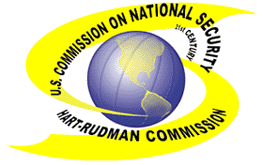
| The U.S. Commission on National Security is a bipartisan effort to identify the threat environment that the U.S. will face in 25 years and propose steps to meet it. The first phase of their work is available for public scrutiny and comment on their homepage . Their efforts and those of other military planners were the subject of a provocative critique by Washington Post writer Bill Arkin. Arkin's site provides links to orginal copies of the reports as well as links to various online military resources as well as his own analysis of several recent operations. |  |